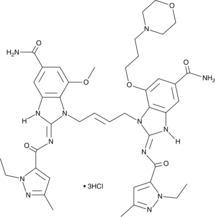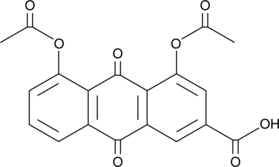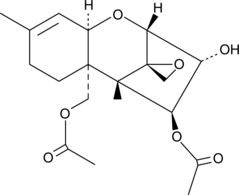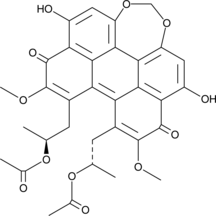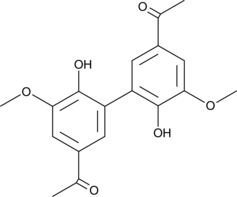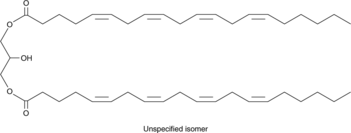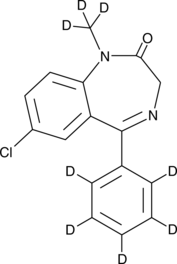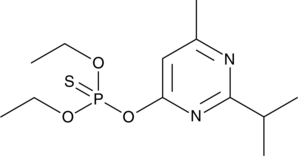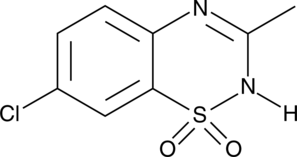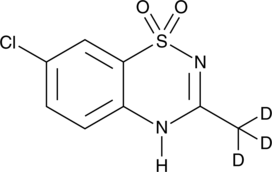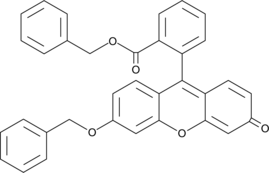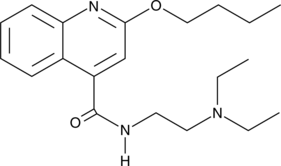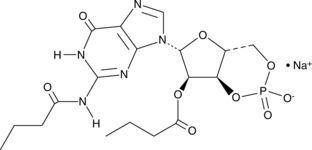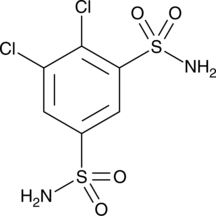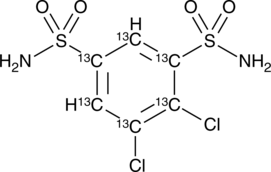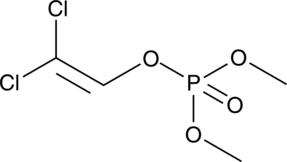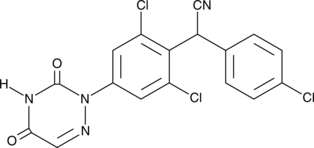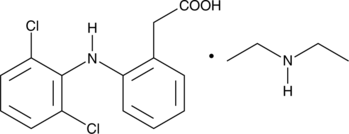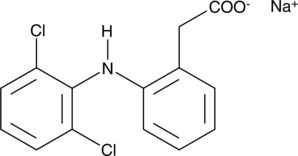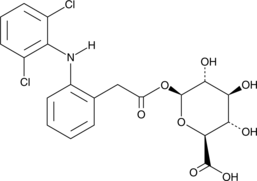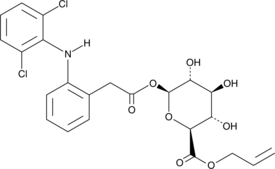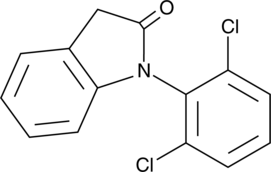Cayman
Showing 18001–18150 of 45550 results
-
diABZI STING agonist 3 is an agonist of the stimulator of interferon genes (STING) pathway.{43612} It induces secretion of IFN-β in human peripheral blood mononuclear cells (PBMCs; EC50 = 130 nM). diABZI STING agonist 3 (2.5 mg/kg) increases serum levels of IFN-β, IL-6, TNF, and KC/GROα in wild-type, but not Sting-/-, mice. It decreases tumor volume and increases survival in a CT26 murine colorectal cancer model when administered at a dose of 3 mg/kg.
Brand:CaymanSKU:28054 - 1 mgAvailable on backorder
diABZI STING agonist 3 is an agonist of the stimulator of interferon genes (STING) pathway.{43612} It induces secretion of IFN-β in human peripheral blood mononuclear cells (PBMCs; EC50 = 130 nM). diABZI STING agonist 3 (2.5 mg/kg) increases serum levels of IFN-β, IL-6, TNF, and KC/GROα in wild-type, but not Sting-/-, mice. It decreases tumor volume and increases survival in a CT26 murine colorectal cancer model when administered at a dose of 3 mg/kg.
Brand:CaymanSKU:28054 - 5 mgAvailable on backorder
diABZI STING agonist 3 is an agonist of the stimulator of interferon genes (STING) pathway.{43612} It induces secretion of IFN-β in human peripheral blood mononuclear cells (PBMCs; EC50 = 130 nM). diABZI STING agonist 3 (2.5 mg/kg) increases serum levels of IFN-β, IL-6, TNF, and KC/GROα in wild-type, but not Sting-/-, mice. It decreases tumor volume and increases survival in a CT26 murine colorectal cancer model when administered at a dose of 3 mg/kg.
Brand:CaymanSKU:28054 - 500 µgAvailable on backorder
Diacerein is a diacetyl precursor of rhein, an anthraquinone found in plants. Rhein, at 10 µM, inhibits IL-1β signaling, suppressing signaling through NF-κB and AP-1, and reduces the expression of the matrix metalloproteases MMP-1 and MMP-13.{25637,25635} Diacerein, presumably after conversion to rhein, down-regulates the expression of the IL-1β receptor on articular chondrocytes, enhances the expression of TGF-β, and increases collagen and aggrecan.{25637} It does not alter COX activity.{25639} It is mildly effective in ameliorating osteoarthritis.{25638,25636}
Brand:CaymanSKU:11710 - 100 mgAvailable on backorder
Diacerein is a diacetyl precursor of rhein, an anthraquinone found in plants. Rhein, at 10 µM, inhibits IL-1β signaling, suppressing signaling through NF-κB and AP-1, and reduces the expression of the matrix metalloproteases MMP-1 and MMP-13.{25637,25635} Diacerein, presumably after conversion to rhein, down-regulates the expression of the IL-1β receptor on articular chondrocytes, enhances the expression of TGF-β, and increases collagen and aggrecan.{25637} It does not alter COX activity.{25639} It is mildly effective in ameliorating osteoarthritis.{25638,25636}
Brand:CaymanSKU:11710 - 25 mgAvailable on backorder
Diacerein is a diacetyl precursor of rhein, an anthraquinone found in plants. Rhein, at 10 µM, inhibits IL-1β signaling, suppressing signaling through NF-κB and AP-1, and reduces the expression of the matrix metalloproteases MMP-1 and MMP-13.{25637,25635} Diacerein, presumably after conversion to rhein, down-regulates the expression of the IL-1β receptor on articular chondrocytes, enhances the expression of TGF-β, and increases collagen and aggrecan.{25637} It does not alter COX activity.{25639} It is mildly effective in ameliorating osteoarthritis.{25638,25636}
Brand:CaymanSKU:11710 - 250 mgAvailable on backorder
Diacerein is a diacetyl precursor of rhein, an anthraquinone found in plants. Rhein, at 10 µM, inhibits IL-1β signaling, suppressing signaling through NF-κB and AP-1, and reduces the expression of the matrix metalloproteases MMP-1 and MMP-13.{25637,25635} Diacerein, presumably after conversion to rhein, down-regulates the expression of the IL-1β receptor on articular chondrocytes, enhances the expression of TGF-β, and increases collagen and aggrecan.{25637} It does not alter COX activity.{25639} It is mildly effective in ameliorating osteoarthritis.{25638,25636}
Brand:CaymanSKU:11710 - 50 mgAvailable on backorder
diacetoxy Scirpenol (DAS) is a potent, trichothecene mycotoxin produced by certain Fusarium strains, which play an important role as plant pathogens, causing a wide range of diseases.{20564} It is toxic to fungi, plants, animals, and various mammalian cell cultures, inhibiting de novo protein synthesis.{20563} In a biological activity assay, DAS was shown to inhibit expression of the Arabidopsis MAMP-responsive reporter gene WRKY29p::GUS with an IC50 value of 50 nM, thereby suppressing a rapid cell death immune response important for plant defense.{20565}
Brand:CaymanSKU:11427 - 1 mgAvailable on backorder
diacetoxy Scirpenol (DAS) is a potent, trichothecene mycotoxin produced by certain Fusarium strains, which play an important role as plant pathogens, causing a wide range of diseases.{20564} It is toxic to fungi, plants, animals, and various mammalian cell cultures, inhibiting de novo protein synthesis.{20563} In a biological activity assay, DAS was shown to inhibit expression of the Arabidopsis MAMP-responsive reporter gene WRKY29p::GUS with an IC50 value of 50 nM, thereby suppressing a rapid cell death immune response important for plant defense.{20565}
Brand:CaymanSKU:11427 - 10 mgAvailable on backorder
diacetoxy Scirpenol (DAS) is a potent, trichothecene mycotoxin produced by certain Fusarium strains, which play an important role as plant pathogens, causing a wide range of diseases.{20564} It is toxic to fungi, plants, animals, and various mammalian cell cultures, inhibiting de novo protein synthesis.{20563} In a biological activity assay, DAS was shown to inhibit expression of the Arabidopsis MAMP-responsive reporter gene WRKY29p::GUS with an IC50 value of 50 nM, thereby suppressing a rapid cell death immune response important for plant defense.{20565}
Brand:CaymanSKU:11427 - 5 mgAvailable on backorder
Diacetylcercosporin is a perylenequinone produced by Cercospora and Septoria that has diverse biological activities.{41238} It inhibits the growth of P. falciparum strains that are sensitive and resistant to chloroquine (Item No. 14194; IC50s = 2.75 and 1.94 μM for D6 and W2 clones, respectively) and L. donovani parasites (IC50 = 3.1 μM) in vitro. Diacetylcercosporin exhibits cytotoxicity against SK-MEL, KB, BT549, and SK-OV-3 human cancer cell lines (IC50s = 4.8-8.7 μM). It is also a phytotoxin that inhibits the growth of lettuce and bentgrass at a concentration of 1.62 mM
Brand:CaymanSKU:23639 - 1 mgAvailable on backorder
Diacetylcercosporin is a perylenequinone produced by Cercospora and Septoria that has diverse biological activities.{41238} It inhibits the growth of P. falciparum strains that are sensitive and resistant to chloroquine (Item No. 14194; IC50s = 2.75 and 1.94 μM for D6 and W2 clones, respectively) and L. donovani parasites (IC50 = 3.1 μM) in vitro. Diacetylcercosporin exhibits cytotoxicity against SK-MEL, KB, BT549, and SK-OV-3 human cancer cell lines (IC50s = 4.8-8.7 μM). It is also a phytotoxin that inhibits the growth of lettuce and bentgrass at a concentration of 1.62 mM
Brand:CaymanSKU:23639 - 500 µgAvailable on backorder
Diallyl disulfide (DADS) is an organosulfur compound derived from allicin, a natural compound found in garlic and related plants. DADS has diverse physiological effects, many that are cardio- and neuro-protective.{16966,16967,16971} These effects are due, at least in part because DADS is converted, in the presence of thiols, to the gaseous mediator hydrogen sulfide (H2S).{16966} Thus, DADS serves as a thiol-dependent H2S donor in biological systems.{16966}
Brand:CaymanSKU:10012582 - 1 gAvailable on backorder
Diallyl disulfide (DADS) is an organosulfur compound derived from allicin, a natural compound found in garlic and related plants. DADS has diverse physiological effects, many that are cardio- and neuro-protective.{16966,16967,16971} These effects are due, at least in part because DADS is converted, in the presence of thiols, to the gaseous mediator hydrogen sulfide (H2S).{16966} Thus, DADS serves as a thiol-dependent H2S donor in biological systems.{16966}
Brand:CaymanSKU:10012582 - 100 mgAvailable on backorder
Diallyl disulfide (DADS) is an organosulfur compound derived from allicin, a natural compound found in garlic and related plants. DADS has diverse physiological effects, many that are cardio- and neuro-protective.{16966,16967,16971} These effects are due, at least in part because DADS is converted, in the presence of thiols, to the gaseous mediator hydrogen sulfide (H2S).{16966} Thus, DADS serves as a thiol-dependent H2S donor in biological systems.{16966}
Brand:CaymanSKU:10012582 - 500 mgAvailable on backorder
Diallyl sulfide is a thioether found in garlic that can modulate the cytochrome P450 drug metabolizing system, activate the constitutive androstane receptor to regulate multidrug resistance-associated proteins, and upregulate the expression of detoxifying enzymes.{27658,21471} Garlic-derived organosulfides such as diallyl sulfide have been shown to be highly protective from chemically-induced carcinogenesis in animals.{16967}
Brand:CaymanSKU:20894 -Out of stock
Diallyl sulfide is a thioether found in garlic that can modulate the cytochrome P450 drug metabolizing system, activate the constitutive androstane receptor to regulate multidrug resistance-associated proteins, and upregulate the expression of detoxifying enzymes.{27658,21471} Garlic-derived organosulfides such as diallyl sulfide have been shown to be highly protective from chemically-induced carcinogenesis in animals.{16967}
Brand:CaymanSKU:20894 -Out of stock
Diallyl sulfide is a thioether found in garlic that can modulate the cytochrome P450 drug metabolizing system, activate the constitutive androstane receptor to regulate multidrug resistance-associated proteins, and upregulate the expression of detoxifying enzymes.{27658,21471} Garlic-derived organosulfides such as diallyl sulfide have been shown to be highly protective from chemically-induced carcinogenesis in animals.{16967}
Brand:CaymanSKU:20894 -Out of stock
Diallyl tetrasulfide is an organosulfur compound that has been found in A. sativum and has diverse biological activities, including antimicrobial, antioxidant, and anticancer properties.{46565,46562,46563,46564} It is active against the bacteria S. aureus and methicillin-resistant S. aureus (MRSA; MICs = 0.5 and 2 mg/L, respectively), as well as the fungi C. albicans, C. krusei, C. glabrata, A. niger, A. flavus, and A. fumigatus (MICs = 0.5, 4, 2, 1, 2, and 4 mg/L, respectively).{46565}It reduces cadmium-induced increases in hepatic levels of thiobarbituric acid reactive substances (TBARS) and increases cadmium-induced decreases in the hepatic activity of superoxide dismutase (SOD1), catalase, GST, and glucose-6-phosphate dehydrogenase (G6PDH) in rats when administered at a dose of 40 mg/kg.{46562} Diallyl tetrasulfide is cytotoxic to MCF-7 breast cancer cells (IC50 = 92 µM) and reduces tumor growth in a BGC-823 mouse xenograft model when administered at doses of 20, 30, and 40 mg/kg for 32 days.{46563,46564}
Brand:CaymanSKU:29328 - 10 mgAvailable on backorder
Diallyl tetrasulfide is an organosulfur compound that has been found in A. sativum and has diverse biological activities, including antimicrobial, antioxidant, and anticancer properties.{46565,46562,46563,46564} It is active against the bacteria S. aureus and methicillin-resistant S. aureus (MRSA; MICs = 0.5 and 2 mg/L, respectively), as well as the fungi C. albicans, C. krusei, C. glabrata, A. niger, A. flavus, and A. fumigatus (MICs = 0.5, 4, 2, 1, 2, and 4 mg/L, respectively).{46565}It reduces cadmium-induced increases in hepatic levels of thiobarbituric acid reactive substances (TBARS) and increases cadmium-induced decreases in the hepatic activity of superoxide dismutase (SOD1), catalase, GST, and glucose-6-phosphate dehydrogenase (G6PDH) in rats when administered at a dose of 40 mg/kg.{46562} Diallyl tetrasulfide is cytotoxic to MCF-7 breast cancer cells (IC50 = 92 µM) and reduces tumor growth in a BGC-823 mouse xenograft model when administered at doses of 20, 30, and 40 mg/kg for 32 days.{46563,46564}
Brand:CaymanSKU:29328 - 25 mgAvailable on backorder
Diallyl tetrasulfide is an organosulfur compound that has been found in A. sativum and has diverse biological activities, including antimicrobial, antioxidant, and anticancer properties.{46565,46562,46563,46564} It is active against the bacteria S. aureus and methicillin-resistant S. aureus (MRSA; MICs = 0.5 and 2 mg/L, respectively), as well as the fungi C. albicans, C. krusei, C. glabrata, A. niger, A. flavus, and A. fumigatus (MICs = 0.5, 4, 2, 1, 2, and 4 mg/L, respectively).{46565}It reduces cadmium-induced increases in hepatic levels of thiobarbituric acid reactive substances (TBARS) and increases cadmium-induced decreases in the hepatic activity of superoxide dismutase (SOD1), catalase, GST, and glucose-6-phosphate dehydrogenase (G6PDH) in rats when administered at a dose of 40 mg/kg.{46562} Diallyl tetrasulfide is cytotoxic to MCF-7 breast cancer cells (IC50 = 92 µM) and reduces tumor growth in a BGC-823 mouse xenograft model when administered at doses of 20, 30, and 40 mg/kg for 32 days.{46563,46564}
Brand:CaymanSKU:29328 - 5 mgAvailable on backorder
Diallyl tetrasulfide is an organosulfur compound that has been found in A. sativum and has diverse biological activities, including antimicrobial, antioxidant, and anticancer properties.{46565,46562,46563,46564} It is active against the bacteria S. aureus and methicillin-resistant S. aureus (MRSA; MICs = 0.5 and 2 mg/L, respectively), as well as the fungi C. albicans, C. krusei, C. glabrata, A. niger, A. flavus, and A. fumigatus (MICs = 0.5, 4, 2, 1, 2, and 4 mg/L, respectively).{46565}It reduces cadmium-induced increases in hepatic levels of thiobarbituric acid reactive substances (TBARS) and increases cadmium-induced decreases in the hepatic activity of superoxide dismutase (SOD1), catalase, GST, and glucose-6-phosphate dehydrogenase (G6PDH) in rats when administered at a dose of 40 mg/kg.{46562} Diallyl tetrasulfide is cytotoxic to MCF-7 breast cancer cells (IC50 = 92 µM) and reduces tumor growth in a BGC-823 mouse xenograft model when administered at doses of 20, 30, and 40 mg/kg for 32 days.{46563,46564}
Brand:CaymanSKU:29328 - 50 mgAvailable on backorder
Hydrogen sulfide (H2S) is an endogenously-produced gaseous second messenger that can regulate many physiological processes. Diallyl trisulfide (DATS) is an organic polysulfide compound found in garlic that acts as an H2S donor.{16966} It reduces the survival of prostate cancer PC-3 cells (IC50 = 22 μM){16967} and inhibits the growth of human colon adenocarcinoma HCT15 cells (IC50 = 11.5 μM).{16969} DATS suppresses the growth of PC-3 xenografts in vivo in mice{16968} and induces vascular smooth muscle relaxation.{16966} Garlic extracts also lower cholesterol and there is evidence that DATS can alter the expression of genes and inhibit enzymes that are relevant to cholesterol synthesis.{16970,16971}
Brand:CaymanSKU:10012577 - 100 mgAvailable on backorder
Hydrogen sulfide (H2S) is an endogenously-produced gaseous second messenger that can regulate many physiological processes. Diallyl trisulfide (DATS) is an organic polysulfide compound found in garlic that acts as an H2S donor.{16966} It reduces the survival of prostate cancer PC-3 cells (IC50 = 22 μM){16967} and inhibits the growth of human colon adenocarcinoma HCT15 cells (IC50 = 11.5 μM).{16969} DATS suppresses the growth of PC-3 xenografts in vivo in mice{16968} and induces vascular smooth muscle relaxation.{16966} Garlic extracts also lower cholesterol and there is evidence that DATS can alter the expression of genes and inhibit enzymes that are relevant to cholesterol synthesis.{16970,16971}
Brand:CaymanSKU:10012577 - 25 mgAvailable on backorder
Hydrogen sulfide (H2S) is an endogenously-produced gaseous second messenger that can regulate many physiological processes. Diallyl trisulfide (DATS) is an organic polysulfide compound found in garlic that acts as an H2S donor.{16966} It reduces the survival of prostate cancer PC-3 cells (IC50 = 22 μM){16967} and inhibits the growth of human colon adenocarcinoma HCT15 cells (IC50 = 11.5 μM).{16969} DATS suppresses the growth of PC-3 xenografts in vivo in mice{16968} and induces vascular smooth muscle relaxation.{16966} Garlic extracts also lower cholesterol and there is evidence that DATS can alter the expression of genes and inhibit enzymes that are relevant to cholesterol synthesis.{16970,16971}
Brand:CaymanSKU:10012577 - 250 mgAvailable on backorder
Hydrogen sulfide (H2S) is an endogenously-produced gaseous second messenger that can regulate many physiological processes. Diallyl trisulfide (DATS) is an organic polysulfide compound found in garlic that acts as an H2S donor.{16966} It reduces the survival of prostate cancer PC-3 cells (IC50 = 22 μM){16967} and inhibits the growth of human colon adenocarcinoma HCT15 cells (IC50 = 11.5 μM).{16969} DATS suppresses the growth of PC-3 xenografts in vivo in mice{16968} and induces vascular smooth muscle relaxation.{16966} Garlic extracts also lower cholesterol and there is evidence that DATS can alter the expression of genes and inhibit enzymes that are relevant to cholesterol synthesis.{16970,16971}
Brand:CaymanSKU:10012577 - 50 mgAvailable on backorder
Diapocynin is the dimeric form of the NADPH oxidase inhibitor apocynin (Item No. 11976) that has anti-inflammatory and antioxidant activities. Diapocynin inhibits NADPH oxidase complex assembly and activation, gp91phox mRNA expression, and production of the pro-inflammatory cytokines TNF-α and IL-10 in peripheral blood mononuclear cells (PMBCs).{38084} It inhibits production of reactive oxygen species (ROS), calcium-independent isoform of phospholipase A2 (iPLA2) function, and reduces Ca2+ influx through store-operated and stretch-activated channels (SOCs and SACs, respectively) in dystrophic myotubes; all functions in the pathogenic cascade leading to muscular dystrophy.{38083} Diapocynin also reverses motor coordination deficits in the LRRK2R1441G mouse model of early Parkinson’s disease.{38082}
Brand:CaymanSKU:-Diapocynin is the dimeric form of the NADPH oxidase inhibitor apocynin (Item No. 11976) that has anti-inflammatory and antioxidant activities. Diapocynin inhibits NADPH oxidase complex assembly and activation, gp91phox mRNA expression, and production of the pro-inflammatory cytokines TNF-α and IL-10 in peripheral blood mononuclear cells (PMBCs).{38084} It inhibits production of reactive oxygen species (ROS), calcium-independent isoform of phospholipase A2 (iPLA2) function, and reduces Ca2+ influx through store-operated and stretch-activated channels (SOCs and SACs, respectively) in dystrophic myotubes; all functions in the pathogenic cascade leading to muscular dystrophy.{38083} Diapocynin also reverses motor coordination deficits in the LRRK2R1441G mouse model of early Parkinson’s disease.{38082}
Brand:CaymanSKU:-Diapocynin is the dimeric form of the NADPH oxidase inhibitor apocynin (Item No. 11976) that has anti-inflammatory and antioxidant activities. Diapocynin inhibits NADPH oxidase complex assembly and activation, gp91phox mRNA expression, and production of the pro-inflammatory cytokines TNF-α and IL-10 in peripheral blood mononuclear cells (PMBCs).{38084} It inhibits production of reactive oxygen species (ROS), calcium-independent isoform of phospholipase A2 (iPLA2) function, and reduces Ca2+ influx through store-operated and stretch-activated channels (SOCs and SACs, respectively) in dystrophic myotubes; all functions in the pathogenic cascade leading to muscular dystrophy.{38083} Diapocynin also reverses motor coordination deficits in the LRRK2R1441G mouse model of early Parkinson’s disease.{38082}
Brand:CaymanSKU:-Diapocynin is the dimeric form of the NADPH oxidase inhibitor apocynin (Item No. 11976) that has anti-inflammatory and antioxidant activities. Diapocynin inhibits NADPH oxidase complex assembly and activation, gp91phox mRNA expression, and production of the pro-inflammatory cytokines TNF-α and IL-10 in peripheral blood mononuclear cells (PMBCs).{38084} It inhibits production of reactive oxygen species (ROS), calcium-independent isoform of phospholipase A2 (iPLA2) function, and reduces Ca2+ influx through store-operated and stretch-activated channels (SOCs and SACs, respectively) in dystrophic myotubes; all functions in the pathogenic cascade leading to muscular dystrophy.{38083} Diapocynin also reverses motor coordination deficits in the LRRK2R1441G mouse model of early Parkinson’s disease.{38082}
Brand:CaymanSKU:-Diarachidonin is a diacylglycerol that contains the ω-6 polyunsaturated 20-carbon fatty acid arachidonic acid (Item Nos. 90010 | 90010.1 | 10006607) at two positions.
Brand:CaymanSKU:26928 - 10 mgAvailable on backorder
Diarachidonin is a diacylglycerol that contains the ω-6 polyunsaturated 20-carbon fatty acid arachidonic acid (Item Nos. 90010 | 90010.1 | 10006607) at two positions.
Brand:CaymanSKU:26928 - 25 mgAvailable on backorder
Diarachidonin is a diacylglycerol that contains the ω-6 polyunsaturated 20-carbon fatty acid arachidonic acid (Item Nos. 90010 | 90010.1 | 10006607) at two positions.
Brand:CaymanSKU:26928 - 5 mgAvailable on backorder
Diarachidonin is a diacylglycerol that contains the ω-6 polyunsaturated 20-carbon fatty acid arachidonic acid (Item Nos. 90010 | 90010.1 | 10006607) at two positions.
Brand:CaymanSKU:26928 - 50 mgAvailable on backorder
Diaveridine is a dihydrofolate reductase (DHFR) inhibitor (Ki = 11.5 nM for the P. falciparum enzyme) with antimicrobial activity.{48808,48809,48811,48810} It is active against P. vulgaris, S. aureus, and S. pyogenes in vitro (MICs = 4, 1, and 2 μg/ml, respectively).{48809} Diaveridine has anticoccidial activity when administered alone or in combination with sulfaquinoxaline.{48811,48810}
Brand:CaymanSKU:29427 - 1 gAvailable on backorder
Diaveridine is a dihydrofolate reductase (DHFR) inhibitor (Ki = 11.5 nM for the P. falciparum enzyme) with antimicrobial activity.{48808,48809,48811,48810} It is active against P. vulgaris, S. aureus, and S. pyogenes in vitro (MICs = 4, 1, and 2 μg/ml, respectively).{48809} Diaveridine has anticoccidial activity when administered alone or in combination with sulfaquinoxaline.{48811,48810}
Brand:CaymanSKU:29427 - 10 gAvailable on backorder
Diaveridine is a dihydrofolate reductase (DHFR) inhibitor (Ki = 11.5 nM for the P. falciparum enzyme) with antimicrobial activity.{48808,48809,48811,48810} It is active against P. vulgaris, S. aureus, and S. pyogenes in vitro (MICs = 4, 1, and 2 μg/ml, respectively).{48809} Diaveridine has anticoccidial activity when administered alone or in combination with sulfaquinoxaline.{48811,48810}
Brand:CaymanSKU:29427 - 5 gAvailable on backorder
Diaveridine is a dihydrofolate reductase (DHFR) inhibitor (Ki = 11.5 nM for the P. falciparum enzyme) with antimicrobial activity.{48808,48809,48811,48810} It is active against P. vulgaris, S. aureus, and S. pyogenes in vitro (MICs = 4, 1, and 2 μg/ml, respectively).{48809} Diaveridine has anticoccidial activity when administered alone or in combination with sulfaquinoxaline.{48811,48810}
Brand:CaymanSKU:29427 - 500 mgAvailable on backorder
Diazepam-d8 (exempt preparation) (Item No. 23786) is intended for use as an internal standard for the quantification of diazepam (Item No. ISO60177) by GC- or LC-MS. Diazepam is categorized as a benzodiazepine.{21302,21009} Diazepam is regulated as a Schedule IV compound in the United States. Diazepam-d8 (exempt preparation) (Item No. 23786) is provided as a DEA exempt preparation. This product is intended for research and forensic applications.
Brand:CaymanSKU:23786 - 1 mgAvailable on backorder
Diazinon is a broad-spectrum insecticide that is active against approximately 120 species of insects and pests.{37261} It is metabolized into the cholinesterase inhibitors monothionotetraethyl pyrophosphate, dithionotetraethyl pyrophosphate, and triethylthionophosphate in vivo, which induce vomiting, fasciculation with muscular twitching, paralysis, and death (LD50 = 125 mg/kg) in rats. Diazinon induces formation of capsular adhesion in the kidneys and ulcer formation in the duodenum of dogs as well as mucosal erosion and serosal seepage in the intestines of mini pigs. Formulations containing diazinon were previously used as agricultural pesticides.
Brand:CaymanSKU:23769 - 100 mgAvailable on backorder
Diazoxide is an activator of sulfonylurea receptor 1 (SUR1) linked to ATP-sensitive potassium channel Kir6.2 (EC50 = 14.1 µM in a FLIPR assay using HEK293 cells).{36318} It also activates SUR2A/Kir6.2 and SUR2B/Kir6.2 channels in HEK293T cells in a patch-clamp assay when used at concentrations of 30 and 300 µM.{48765} Diazoxide inhibits glucose-induced insulin release from isolated rat pancreatic β cells and induces relaxation of isolated rat aortic rings precontracted with potassium chloride (IC50s = 22.6 and 22.4 µM, respectively).{48766} It reduces mean arterial pressure and cerebral blood flow in spontaneously hypertensive rats when administered intravenously as a 5 mg/kg bolus dose.{48767} Diazoxide (50 mg/kg, i.p.) increases blood glucose levels in mice.{48768} Formulations containing diazoxide have been used in the treatment of hypoglycemia.
Brand:CaymanSKU:-Diazoxide-d3 is intended for use as an internal standard for the quantification of diazoxide (Item No. 14576) by GC- or LC-MS. Diazoxide is an activator of sulfonylurea receptor 1 (SUR1) linked to ATP-sensitive potassium channel Kir6.2 (EC50 = 14.1 µM in a FLIPR assay using HEK293 cells).{36318} It also activates SUR2A/Kir6.2 and SUR2B/Kir6.2 channels in HEK293T cells in a patch-clamp assay when used at concentrations of 30 and 300 µM.{48765} Diazoxide inhibits glucose-induced insulin release from isolated rat pancreatic β cells and induces relaxation of isolated rat aortic rings precontracted with potassium chloride (IC50s = 22.6 and 22.4 µM, respectively).{48766} It reduces mean arterial pressure and cerebral blood flow in spontaneously hypertensive rats when administered intravenously as a 5 mg/kg bolus dose.{48767} Diazoxide (50 mg/kg, i.p.) increases blood glucose levels in mice.{48768} Formulations containing diazoxide have been used in the treatment of hypoglycemia.
Brand:CaymanSKU:29967 - 1 mgAvailable on backorder
Dibenzylfluorescein is a fluorogenic probe that acts as a substrate for specific cytochrome P450 (CYP) isoforms, including CYP3A4, CYP2C8, CYP2C9, CYP2C19, and aromatase (CYP19).{27561,27560,27562} Dibenzylfluorescein is dealkylated by these CYP isoforms to produce fluorescein benzyl ether, which is further hydrolyzed to fluorescein by the addition of base (typically 2 M NaOH).{27562} Dibenzylfluorescein is typically used near its apparent Km value of 0.87-1.9 µM.{27561,27560,27562} The fluorescence of fluorescein is evaluated using excitation/emission wavelengths of 485/538 nm. Dibenzylfluorescein is used to detect changes in CYP catalytic activity caused by drugs or disease.{27561,27563}
Brand:CaymanSKU:-Out of stock
Dibenzylfluorescein is a fluorogenic probe that acts as a substrate for specific cytochrome P450 (CYP) isoforms, including CYP3A4, CYP2C8, CYP2C9, CYP2C19, and aromatase (CYP19).{27561,27560,27562} Dibenzylfluorescein is dealkylated by these CYP isoforms to produce fluorescein benzyl ether, which is further hydrolyzed to fluorescein by the addition of base (typically 2 M NaOH).{27562} Dibenzylfluorescein is typically used near its apparent Km value of 0.87-1.9 µM.{27561,27560,27562} The fluorescence of fluorescein is evaluated using excitation/emission wavelengths of 485/538 nm. Dibenzylfluorescein is used to detect changes in CYP catalytic activity caused by drugs or disease.{27561,27563}
Brand:CaymanSKU:-Out of stock
Dibenzylfluorescein is a fluorogenic probe that acts as a substrate for specific cytochrome P450 (CYP) isoforms, including CYP3A4, CYP2C8, CYP2C9, CYP2C19, and aromatase (CYP19).{27561,27560,27562} Dibenzylfluorescein is dealkylated by these CYP isoforms to produce fluorescein benzyl ether, which is further hydrolyzed to fluorescein by the addition of base (typically 2 M NaOH).{27562} Dibenzylfluorescein is typically used near its apparent Km value of 0.87-1.9 µM.{27561,27560,27562} The fluorescence of fluorescein is evaluated using excitation/emission wavelengths of 485/538 nm. Dibenzylfluorescein is used to detect changes in CYP catalytic activity caused by drugs or disease.{27561,27563}
Brand:CaymanSKU:-Out of stock
Dibenzylfluorescein is a fluorogenic probe that acts as a substrate for specific cytochrome P450 (CYP) isoforms, including CYP3A4, CYP2C8, CYP2C9, CYP2C19, and aromatase (CYP19).{27561,27560,27562} Dibenzylfluorescein is dealkylated by these CYP isoforms to produce fluorescein benzyl ether, which is further hydrolyzed to fluorescein by the addition of base (typically 2 M NaOH).{27562} Dibenzylfluorescein is typically used near its apparent Km value of 0.87-1.9 µM.{27561,27560,27562} The fluorescence of fluorescein is evaluated using excitation/emission wavelengths of 485/538 nm. Dibenzylfluorescein is used to detect changes in CYP catalytic activity caused by drugs or disease.{27561,27563}
Brand:CaymanSKU:-Out of stock
Dibucaine (Item No. 22237) is an analytical reference standard that is categorized as an anesthetic.{38099,38100} This product is intended for research and forensic applications.
Brand:CaymanSKU:22237 -Out of stock
Dibucaine (Item No. 22237) is an analytical reference standard that is categorized as an anesthetic.{38099,38100} This product is intended for research and forensic applications.
Brand:CaymanSKU:22237 -Out of stock
Dibutyl 3-hydroxybutyl phosphate is a compound produced from the metabolism of the organophosphorus solvent, tributyl phosphate (TBP). Incubation of goldfish liver microsomes in the presence of NADPH has been shown to convert TBP into dibutyl-3-hydroxybutyl phosphate and dibutyl phosphate.{23881} Dibutyl-3-hydroxybutyl phosphate has also been produced during radiolysis of TBP.{23882}
Brand:CaymanSKU:9001825 - 1 mgAvailable on backorder
Dibutyl 3-hydroxybutyl phosphate is a compound produced from the metabolism of the organophosphorus solvent, tributyl phosphate (TBP). Incubation of goldfish liver microsomes in the presence of NADPH has been shown to convert TBP into dibutyl-3-hydroxybutyl phosphate and dibutyl phosphate.{23881} Dibutyl-3-hydroxybutyl phosphate has also been produced during radiolysis of TBP.{23882}
Brand:CaymanSKU:9001825 - 10 mgAvailable on backorder
Dibutyl 3-hydroxybutyl phosphate is a compound produced from the metabolism of the organophosphorus solvent, tributyl phosphate (TBP). Incubation of goldfish liver microsomes in the presence of NADPH has been shown to convert TBP into dibutyl-3-hydroxybutyl phosphate and dibutyl phosphate.{23881} Dibutyl-3-hydroxybutyl phosphate has also been produced during radiolysis of TBP.{23882}
Brand:CaymanSKU:9001825 - 25 mgAvailable on backorder
Dibutyl 3-hydroxybutyl phosphate is a compound produced from the metabolism of the organophosphorus solvent, tributyl phosphate (TBP). Incubation of goldfish liver microsomes in the presence of NADPH has been shown to convert TBP into dibutyl-3-hydroxybutyl phosphate and dibutyl phosphate.{23881} Dibutyl-3-hydroxybutyl phosphate has also been produced during radiolysis of TBP.{23882}
Brand:CaymanSKU:9001825 - 5 mgAvailable on backorder
Dibutyryl-cyclic GMP (dibutyryl-cGMP) is a cell-permeable, cGMP analog that activates cGMP-dependent protein kinase.{26157} It has been used in a wide variety of research applications to mimic cGMP interactions and effects on different biological molecules.{26161,26159,26158,26160}
Brand:CaymanSKU:-Dibutyryl-cyclic GMP (dibutyryl-cGMP) is a cell-permeable, cGMP analog that activates cGMP-dependent protein kinase.{26157} It has been used in a wide variety of research applications to mimic cGMP interactions and effects on different biological molecules.{26161,26159,26158,26160}
Brand:CaymanSKU:-Dibutyryl-cyclic GMP (dibutyryl-cGMP) is a cell-permeable, cGMP analog that activates cGMP-dependent protein kinase.{26157} It has been used in a wide variety of research applications to mimic cGMP interactions and effects on different biological molecules.{26161,26159,26158,26160}
Brand:CaymanSKU:-Dichlorphenamide is a sulfonamide and an orally bioavailable carbonic anhydrase (CA) inhibitor (Kis = 1.20, 38, 50, and 50 nM for the human CA isoforms CAI, CAII, CAIX, and CAXII, respectively).{36212} It lowers intraocular pressure in rabbits when 50 µl of a 10% solution is applied topically to the eye.{36213} Dichlorphenamide rescues the potassium deficiency and prevents insulin-induced paralysis in a rat model of familial hypokalemic periodic paralysis when administered at a dose of 5.6 mg/kg per day for ten days.{36214} Formulations containing dichlorphenamide have been used in the treatment of glaucoma and primary periodic paralysis.
Brand:CaymanSKU:23658 - 10 mgAvailable on backorder
Dichlorphenamide is a sulfonamide and an orally bioavailable carbonic anhydrase (CA) inhibitor (Kis = 1.20, 38, 50, and 50 nM for the human CA isoforms CAI, CAII, CAIX, and CAXII, respectively).{36212} It lowers intraocular pressure in rabbits when 50 µl of a 10% solution is applied topically to the eye.{36213} Dichlorphenamide rescues the potassium deficiency and prevents insulin-induced paralysis in a rat model of familial hypokalemic periodic paralysis when administered at a dose of 5.6 mg/kg per day for ten days.{36214} Formulations containing dichlorphenamide have been used in the treatment of glaucoma and primary periodic paralysis.
Brand:CaymanSKU:23658 - 25 mgAvailable on backorder
Dichlorphenamide is a sulfonamide and an orally bioavailable carbonic anhydrase (CA) inhibitor (Kis = 1.20, 38, 50, and 50 nM for the human CA isoforms CAI, CAII, CAIX, and CAXII, respectively).{36212} It lowers intraocular pressure in rabbits when 50 µl of a 10% solution is applied topically to the eye.{36213} Dichlorphenamide rescues the potassium deficiency and prevents insulin-induced paralysis in a rat model of familial hypokalemic periodic paralysis when administered at a dose of 5.6 mg/kg per day for ten days.{36214} Formulations containing dichlorphenamide have been used in the treatment of glaucoma and primary periodic paralysis.
Brand:CaymanSKU:23658 - 5 mgAvailable on backorder
Dichlorphenamide is a sulfonamide and an orally bioavailable carbonic anhydrase (CA) inhibitor (Kis = 1.20, 38, 50, and 50 nM for the human CA isoforms CAI, CAII, CAIX, and CAXII, respectively).{36212} It lowers intraocular pressure in rabbits when 50 µl of a 10% solution is applied topically to the eye.{36213} Dichlorphenamide rescues the potassium deficiency and prevents insulin-induced paralysis in a rat model of familial hypokalemic periodic paralysis when administered at a dose of 5.6 mg/kg per day for ten days.{36214} Formulations containing dichlorphenamide have been used in the treatment of glaucoma and primary periodic paralysis.
Brand:CaymanSKU:23658 - 50 mgAvailable on backorder
Dichlorphenamide-13C6 is intended for use as an internal standard for the quantification of dichlorphenamide (Item No. 23658) by GC- or LC-MS. Dichlorphenamide is a sulfonamide and an orally bioavailable carbonic anhydrase (CA) inhibitor (Kis = 1.20, 38, 50, and 50 nM for the human CA isoforms CAI, CAII, CAIX, and CAXII, respectively).{36212} It lowers intraocular pressure in rabbits when 50 µl of a 10% solution is applied topically to the eye.{36213} Dichlorphenamide rescues the potassium deficiency and prevents insulin-induced paralysis in a rat model of familial hypokalemic periodic paralysis when administered at a dose of 5.6 mg/kg per day for ten days.{36214} Formulations containing dichlorphenamide have been used in the treatment of glaucoma and primary periodic paralysis.
Brand:CaymanSKU:30719 - 1 mgAvailable on backorder
Dichlorvos is an organophosphate insecticide and inhibitor of acetylcholinesterase (AChE) and butyrylcholinesterase (BChE; IC50s = 269 and 44 nM, respectively).{38709} It also binds to the M2 muscarinic receptor in rat heart homogenates.{38710} Dichlorvos is lethal to 4-week old German cockroach (B. germanica) nymphs (LD50 = 0.108 μg per insect) and silkworms (B. mori) in third instar (LC50 = 6.63 mg/L) after 24 hours.{38711,38712} It is lethal to zebrafish (D. rerio) embryos (LC50 = 39.75 mg/L after 24 hours) and decreases swimming activity of larvae 6 days after fertilization when administered at a concentration of 25 mg/L in tank water.{38713} Dichlorvos (150 ppm for 80 weeks) also increases the incidence of benign and malignant neoplasms in male rats from 47 to 88% as compared to controls.{38714}
Brand:CaymanSKU:23727 - 100 mgAvailable on backorder
Diclazuril is an anticoccidial agent.{51206,51207} It decreases the number of oocysts per gram of feces in a broiler chicken model of E. tenella coccidiosis infection.{51206} Diclazuril (1 and 2 mg/kg) decreases fecal oocyst shedding in goat kid models of E. arloingi, E. ninakohlyakimovae, and E. christenseni infection.{51207} It also inhibits B. besnoiti tachyzoite proliferation in MARC-145 cells (IC99 = 29.9 μM).{51208} Formulations containing diclazuril have been used in the prevention and treatment of coccidiosis in livestock.
Brand:CaymanSKU:27047 - 10 gAvailable on backorder
Diclazuril is an anticoccidial agent.{51206,51207} It decreases the number of oocysts per gram of feces in a broiler chicken model of E. tenella coccidiosis infection.{51206} Diclazuril (1 and 2 mg/kg) decreases fecal oocyst shedding in goat kid models of E. arloingi, E. ninakohlyakimovae, and E. christenseni infection.{51207} It also inhibits B. besnoiti tachyzoite proliferation in MARC-145 cells (IC99 = 29.9 μM).{51208} Formulations containing diclazuril have been used in the prevention and treatment of coccidiosis in livestock.
Brand:CaymanSKU:27047 - 25 gAvailable on backorder
Diclazuril is an anticoccidial agent.{51206,51207} It decreases the number of oocysts per gram of feces in a broiler chicken model of E. tenella coccidiosis infection.{51206} Diclazuril (1 and 2 mg/kg) decreases fecal oocyst shedding in goat kid models of E. arloingi, E. ninakohlyakimovae, and E. christenseni infection.{51207} It also inhibits B. besnoiti tachyzoite proliferation in MARC-145 cells (IC99 = 29.9 μM).{51208} Formulations containing diclazuril have been used in the prevention and treatment of coccidiosis in livestock.
Brand:CaymanSKU:27047 - 5 gAvailable on backorder
Diclazuril is an anticoccidial agent.{51206,51207} It decreases the number of oocysts per gram of feces in a broiler chicken model of E. tenella coccidiosis infection.{51206} Diclazuril (1 and 2 mg/kg) decreases fecal oocyst shedding in goat kid models of E. arloingi, E. ninakohlyakimovae, and E. christenseni infection.{51207} It also inhibits B. besnoiti tachyzoite proliferation in MARC-145 cells (IC99 = 29.9 μM).{51208} Formulations containing diclazuril have been used in the prevention and treatment of coccidiosis in livestock.
Brand:CaymanSKU:27047 - 50 gAvailable on backorder
Diclofenac is a non-steroidal anti-inflammatory drug (NSAID) that inhibits human COX-1 and -2 with IC50 values of 0.9-2.7 and 1.5-20 µM, respectively.{39325,1791,1286} Formulations containing diclofenac reduce inflammation and pain associated with osteoarthritis, rheumatoid arthritis, gout, and ankylosing spondylitis.{1791,1286,39326} Diclofenac (diethylamine) has increased ex vivo skin permeability over diclofenac (sodium salt) (Item No. 70680), and topical formulations containing diclofenac (diethylamine) have been used to decrease pain without the gastrointestinal side effects associated with oral administration in patients with rheumatoid arthritis.{39326,39325}
Brand:CaymanSKU:22983 - 1 gAvailable on backorder
Diclofenac is a non-steroidal anti-inflammatory drug (NSAID) that inhibits human COX-1 and -2 with IC50 values of 0.9-2.7 and 1.5-20 µM, respectively.{39325,1791,1286} Formulations containing diclofenac reduce inflammation and pain associated with osteoarthritis, rheumatoid arthritis, gout, and ankylosing spondylitis.{1791,1286,39326} Diclofenac (diethylamine) has increased ex vivo skin permeability over diclofenac (sodium salt) (Item No. 70680), and topical formulations containing diclofenac (diethylamine) have been used to decrease pain without the gastrointestinal side effects associated with oral administration in patients with rheumatoid arthritis.{39326,39325}
Brand:CaymanSKU:22983 - 10 gAvailable on backorder
Diclofenac is a non-steroidal anti-inflammatory drug (NSAID) that inhibits human COX-1 and -2 with IC50 values of 0.9-2.7 and 1.5-20 µM, respectively.{39325,1791,1286} Formulations containing diclofenac reduce inflammation and pain associated with osteoarthritis, rheumatoid arthritis, gout, and ankylosing spondylitis.{1791,1286,39326} Diclofenac (diethylamine) has increased ex vivo skin permeability over diclofenac (sodium salt) (Item No. 70680), and topical formulations containing diclofenac (diethylamine) have been used to decrease pain without the gastrointestinal side effects associated with oral administration in patients with rheumatoid arthritis.{39326,39325}
Brand:CaymanSKU:22983 - 5 gAvailable on backorder
Diclofenac is a non-steroidal anti-inflammatory drug (NSAID) that inhibits human COX-1 and -2 with IC50 values of 0.9-2.7 and 1.5-20 µM, respectively.{39325,1791,1286} Formulations containing diclofenac reduce inflammation and pain associated with osteoarthritis, rheumatoid arthritis, gout, and ankylosing spondylitis.{1791,1286,39326} Diclofenac (diethylamine) has increased ex vivo skin permeability over diclofenac (sodium salt) (Item No. 70680), and topical formulations containing diclofenac (diethylamine) have been used to decrease pain without the gastrointestinal side effects associated with oral administration in patients with rheumatoid arthritis.{39326,39325}
Brand:CaymanSKU:22983 - 50 gAvailable on backorder
Diclofenac is a non-selective COX inhibitor.{1791,1286,1364} It inhibits human COX-1 and -2 with IC50 values of 0.9-2.7 and 1.5-20 µM, respectively.{1791,1286} Diclofenac inhibits ovine COX-1 and -2 with IC50 values of 60 and 220 nM, respectively.{1364}
Brand:CaymanSKU:70680 - 100 gAvailable on backorder
Diclofenac is a non-selective COX inhibitor.{1791,1286,1364} It inhibits human COX-1 and -2 with IC50 values of 0.9-2.7 and 1.5-20 µM, respectively.{1791,1286} Diclofenac inhibits ovine COX-1 and -2 with IC50 values of 60 and 220 nM, respectively.{1364}
Brand:CaymanSKU:70680 - 25 gAvailable on backorder
Diclofenac is a non-selective COX inhibitor.{1791,1286,1364} It inhibits human COX-1 and -2 with IC50 values of 0.9-2.7 and 1.5-20 µM, respectively.{1791,1286} Diclofenac inhibits ovine COX-1 and -2 with IC50 values of 60 and 220 nM, respectively.{1364}
Brand:CaymanSKU:70680 - 5 gAvailable on backorder
Diclofenac is a non-selective COX inhibitor.{1791,1286,1364} It inhibits human COX-1 and -2 with IC50 values of 0.9-2.7 and 1.5-20 µM, respectively.{1791,1286} Diclofenac inhibits ovine COX-1 and -2 with IC50 values of 60 and 220 nM, respectively.{1364}
Brand:CaymanSKU:70680 - 50 gAvailable on backorder
Diclofenac acyl-β-D-glucuronide is an active metabolite of diclofenac (Item No. 70680) and the predominant metabolite in rat.{36041} Diclofenac acyl-β-D-glucuronide is acutely toxic in vitro, suggesting it may play a role in the hepatotoxicty of diclofenac in vivo.{36040} Diclofenac acyl-β-D-glucuronide binds to organic anion transporters (OATs; Km = 60.2, 8.6, 112, and 103.9 µM for OAT1-4, respectively) as well as multi-drug resistance proteins.{36043} High levels of diclofenac are found in waste water treatment plant samples, which may be due to the back-transformation of diclofenac acyl-β-D-glucuronide to diclofenac.{36042}
Brand:CaymanSKU:22455 -Out of stock
Diclofenac acyl-β-D-glucuronide is an active metabolite of diclofenac (Item No. 70680) and the predominant metabolite in rat.{36041} Diclofenac acyl-β-D-glucuronide is acutely toxic in vitro, suggesting it may play a role in the hepatotoxicty of diclofenac in vivo.{36040} Diclofenac acyl-β-D-glucuronide binds to organic anion transporters (OATs; Km = 60.2, 8.6, 112, and 103.9 µM for OAT1-4, respectively) as well as multi-drug resistance proteins.{36043} High levels of diclofenac are found in waste water treatment plant samples, which may be due to the back-transformation of diclofenac acyl-β-D-glucuronide to diclofenac.{36042}
Brand:CaymanSKU:22455 -Out of stock
Diclofenac acyl-β-D-glucuronide allyl ester is an intermediate in the synthesis of the COX inhibitor metabolite diclofenac acyl-β-D-glucuronide (Item No. 22455).{36041}
Brand:CaymanSKU:27828 - 10 mgAvailable on backorder
Diclofenac acyl-β-D-glucuronide allyl ester is an intermediate in the synthesis of the COX inhibitor metabolite diclofenac acyl-β-D-glucuronide (Item No. 22455).{36041}
Brand:CaymanSKU:27828 - 2.5 mgAvailable on backorder
Diclofenac acyl-β-D-glucuronide allyl ester is an intermediate in the synthesis of the COX inhibitor metabolite diclofenac acyl-β-D-glucuronide (Item No. 22455).{36041}
Brand:CaymanSKU:27828 - 5 mgAvailable on backorder
Diclofenac amide is a prodrug form of the non-steroidal anti-inflammatory drug (NSAID) diclofenac (Item Nos. 70680 | 22983).{52034} It decreases paw thickness in a rat model of carrageenan-induced paw edema when administered at a dose of 100 μmol/kg and decreases acetic acid-induced writhing in mice at 100 μmol/kg.{52035} Diclofenac amide has reduced ulcerogenicity in rats compared to diclofenac. It is also a degradation product of diclofenac resulting from photo-transformation or spontaneous cyclization in strongly acidic pH conditions.{52036,52037} Diclofenac amide has been used as a synthetic intermediate in the synthesis of compounds with anticancer activity as well as compounds with COX-1, COX-2, and/or 5-lipoxygenase (5-LO) inhibitory activity.{52038,52039}
Brand:CaymanSKU:21969 -Out of stock
Diclofenac amide is a prodrug form of the non-steroidal anti-inflammatory drug (NSAID) diclofenac (Item Nos. 70680 | 22983).{52034} It decreases paw thickness in a rat model of carrageenan-induced paw edema when administered at a dose of 100 μmol/kg and decreases acetic acid-induced writhing in mice at 100 μmol/kg.{52035} Diclofenac amide has reduced ulcerogenicity in rats compared to diclofenac. It is also a degradation product of diclofenac resulting from photo-transformation or spontaneous cyclization in strongly acidic pH conditions.{52036,52037} Diclofenac amide has been used as a synthetic intermediate in the synthesis of compounds with anticancer activity as well as compounds with COX-1, COX-2, and/or 5-lipoxygenase (5-LO) inhibitory activity.{52038,52039}
Brand:CaymanSKU:21969 -Out of stock
Diclofenac amide is a prodrug form of the non-steroidal anti-inflammatory drug (NSAID) diclofenac (Item Nos. 70680 | 22983).{52034} It decreases paw thickness in a rat model of carrageenan-induced paw edema when administered at a dose of 100 μmol/kg and decreases acetic acid-induced writhing in mice at 100 μmol/kg.{52035} Diclofenac amide has reduced ulcerogenicity in rats compared to diclofenac. It is also a degradation product of diclofenac resulting from photo-transformation or spontaneous cyclization in strongly acidic pH conditions.{52036,52037} Diclofenac amide has been used as a synthetic intermediate in the synthesis of compounds with anticancer activity as well as compounds with COX-1, COX-2, and/or 5-lipoxygenase (5-LO) inhibitory activity.{52038,52039}
Brand:CaymanSKU:21969 -Out of stock
